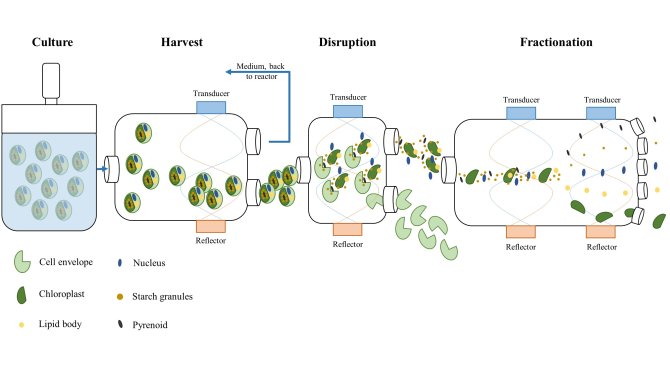
Project
Single-step disentanglement and fractionation of microalgal high-value products through acoustophoresis
Mass production of biomass-based biofuels and biocommodities is required to disrupt the current fossil-based ones. Microalgae, could play a key role in these endeavours, due to their increased photosynthesis efficiencies, independence from quality arable land and ability to uptake CO2 while growing on liquid effluents. However, novel microalgal disruption, extraction and fractionation strategies need to be developed in order to compete with the current mature oil-refinery technologies.
Introduction
Next generation biomass resources such as marine seaweed and micro-algae have advantages in comparison to terrestrial lignocellulosic biomass as they can grow on non-arable land at higher areal productivities. Aquatic biomass can provide renewable energy (e.g. biodiesel, bioethanol and biogas) as well as high-value molecules such as carotenoids, fatty acids, carbohydrates, proteins and food fibers, which can be used in food, feed, cosmetics, biomaterials, nanostructures and pharmaceutical industries. However, in order to greatly increase the economic viability of aquatic biomass, all components found in the biomass need to be valorized. Unfortunately, valorization of multiple biomass components is not possible using current/conventional biorefinery technologies, where up to 90% of the biomass is being treated as a waste. The value of these broken-down compounds sees more than a ten-fold reduction, rendering the biorefinery economically unfeasible.

Aim
Therefore, in furtherance of developing multiproduct biorefineries, selective and economically feasible extraction and separation technologies will need to be developed and implemented. Significant microalgal cell disruption and extraction advances have been recently made by employing external fields such as lasers, ultrasonic waves and microwaves, in combination with less aggressive solvents and ionic liquids. However, the issues regarding the use of chemicals and multiple separation stages remain. Thus, we are proposing a game-changing single-step disentanglement and separation of microalgal high-value components by using acoustic waves at different frequencies allowing thus a complete process finetuning and eliminating the need for chemicals. Moreover, by including our previously-developed ultrasound disruption technology, the whole cell breakdown, extraction and separation steps could be reduced to one single process governed and finely-tuned through the employed frequency ranges.
Approach
The work performed during the implementation of this project will look at several specific key elements, such as:
- Identifying and isolating various microalgal cellular components
- Understand the nature of microalgal cell debris generated through ultrasound disruption processes
- Determining the optimal compound disentanglement conditions by identify the impact of different ultrasound frequencies on the change in microalgal particle size distribution
- Determine the subsequent ultrasound fractionation potential of the extracted microalgal molecules through modelling and simulation approaches backed by experimental observations
- Design and test a proof-of-concept “lab-on-a-chip” integrated system for the simultaneous disentanglement and separation of microalgal added-value components using ultrasound field forces.
Thesis project
There are different topics available for MSc thesis within the AlgCoustics project. If you are interested, please feel free to contact: